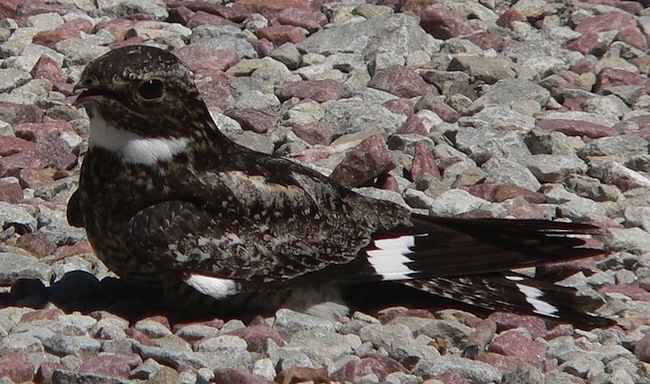 This is an example of a Common Nighthawk employing gular fluttering to cool itself.
This is an example of a Common Nighthawk employing gular fluttering to cool itself.Last week, I gave out some tips for helping birds stay cool in heat waves, but for all those unfortunate wild birds that don’t have awesome people providing water and shade, interesting behavioral adaptations keep their internal temperatures down.
If you took a bird’s temperature, you’d probably think it had a fever. That’s because birds have a resting body temperature much higher than ours at 105 degrees Fahrenheit. There are many benefits of having such a high body temperature, including metabolic reasons, but it also increases the risk of overheating. As a result, they’ve developed these strategies to keep themselves cool.
Gular Fluttering
We commonly associate panting with dogs, but you might be surprised to learn that birds also do a version of panting when they’re hot. When we become hot, we perspire, which removes heat when the sweat evaporates. Birds, on the other hand, do not sweat. To cool themselves, they open their mouths and flutter their neck muscles, giving the appearance of panting. Doing so helps to increase airflow and oxygen levels while simultaneously allowing water to evaporate off their tongue. While it makes them cooler, this leads to the loss of water, which is why having a birdbath with fresh water is important.
Spread Eagle
When I get hot, all I want to do is stretch out on the floor in front of fan. In a way, this is also a strategy some birds employ when they get hot. If a bird is overheating, it sits still, opens up its wings and puffs out its feathers. What this does is allow a cool breeze to hit its body and keep the warm feathers as far as possible.
Taking It Easy
Just like most of us, when the heat becomes unbearable, we simply stop moving around and doing arduous tasks. When a bird gets hot, it decreases its activity level, so it doesn’t have to expend a large amount of energy.
Shade
The difference between being in direct sunlight and being under a tree in the shade is remarkable. That’s why birds tend to seek the shelter of a tree or awning during the hottest parts of the day. Providing shelter in your yard, whether an awning or ample shade from shrubbery, is a great way to help birds beat the heat.
 A Crimson Rosella bathing in Australia.
A Crimson Rosella bathing in Australia.Bathing
Birds love splashing around in water and using it to cool themselves. Having birdbaths, fountains or misters in your yard helps them out tremendously because wet feathers reduce their body temperature.
Migrating
You’ve heard of birds migrating south for the winter to escape the cold weather, but they may also migrate in a way that keeps them in cooler temperatures. Some birds may even travel up mountains to higher elevations in order to escape the heat.
As temperatures around the country continue their upward trend, it’s expected that birds will continue adapting to the weather and developing new strategies to keep cool.



